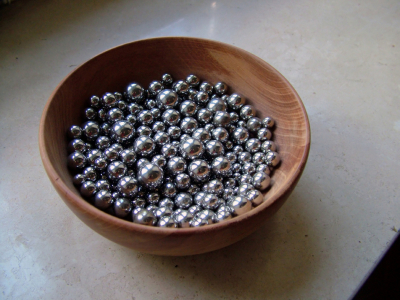How are the balls in ball bearings made?

There's something about the perfectly smooth and spherical nature of the ball inside ball bearings which makes them one of the most exquisite yet simple parts in engineering. The stainless steel balls are never rough or misshapen, so how are they manufactured to be perfect every time? We'll take you through the neat process step-by-step.
1. The shape is formed:
The whole process begins with a rod of metal wire which is approximately the same diameter as the finished ball will be. First of all it goes through a hot or cold forming operation. The wire is fed through a heading machine which has a metal indent in the shape of a hemisphere on either side. This slams shut heavily on the wire, forcing the metal into the rough shape of a sphere. Because the machine comes down either side of the rod it leaves a metal ring around the middle of the ball known as the flash.
2. Removing the flash:
The next stage is to remove the flash. A nifty machine which uses two rill plates refines the shape of the ball making it into a perfect sphere. The rill plates are two ridged circular plates with the middle cut out like a polo. One plate remains stationary, whilst the other spins around. The balls move in a circular path around the plates between different grooves and slowly get whittled down into a perfect shape. Since the balls will move between ridges they all end up the same size. The mechanism is similar to rolling a ball of dough between your hands.
3. Cooling and hardening:
Removing the flash and refining the shape of the ball creates a lot of heat so water is poured over the balls and rill plates to cool them during the process. The rill process hardens the balls through compacting them, but if they need to be harder they can be heat treated after cooling.
4. Grinding:
The balls have to be a very precise size sometimes within millionths of an inch so they have to go through a few more processes to perfect their shape. Grinding uses the same kind of rill plate machine but instead of pouring water over the machine an abrasive is used to weed out any discrepancies.
5. Polishing:
To polish the balls and give them their perfectly smooth finish they're put through a lapping operation. Grill plates are used again but less pressure is put upon the balls and the plates themselves are softer. This time a polishing paste is used in place of an abrasive to make the surface perfectly smooth and shiny without removing any more material which would alter the shape and size of the ball.
Once these processes have happened the balls then are sent to be inspected to ensure they met specific manufacturing requirements.
